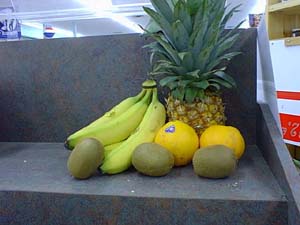Transport and Distribution
Below: Exported fruit: pineapple, oranges, bananas and kiwis.
In today's world, food is one of the great travelers. Try to recall some of the fruits you recently consumed . . . the orange, was it not from Florida? The mango, from Mexico, the kiwi from New Zealand and the banana from Costa Rica? Many fruits, vegetables, meats and various other food products travel a long way before arriving on the supermarket shelves. Of course, there is also a lot of food production which occurs near urban regions, which provide a supply of, for example, fresh milk and eggs. But food still needs to be transported and distributed to the various retail outlets, regardless of its point of origin. How does agricultural produce reach the consumer? Most of the time, food is transported by truck, rail and barge. In the United States, where the situation is comparable to Canada, about 41% of agricultural goods are transported by truck, 40% by rail and 19% by barge (Pimentel et al, 1996). On average, foods are transported for 1,000 km. Travelling such a distance represents a considerable energy expenditure that is eventually reflected in the price of food.